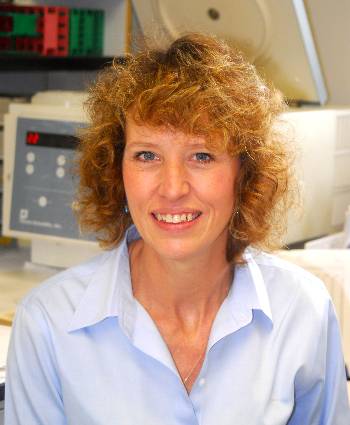Featured Articles/Researchers
Featured UND Investigator
Holly Brown-Borg

Holly Brown-Borg, Ph.D. is a Professor in the Department of Biomedical Sciences. She received a Ph.D. from North Carolina State University and M.S. and B.S. degrees from the University of Nebraska-Lincoln. She completed two postdocs, one at the School of Medicine at Southern Illinois University and the other at the USDA Meat Animal Research Center in Nebraska.
Dr. Brown-Borg currently has a pilot proposal from the Epigenomics COBRE that plans to identify factors that impact resistance to hepatic disease under high-fat conditions. The animal system utilized in these studies are Ames dwarf mice. Not lonely do Ames mice live 50% longer than wild type siblings, they are also healthier and resist age-related disease. Old Ames mouse livers also maintain a young DNA methylation pattern when compared to age-matched control tissues suggesting that DNA methylation contributes to their health span and longevity. When these animals are fed high-fat diets, they do not develop fatty livers nor symptoms of metabolic syndrome. Thus, the pilot project will determine potential epigenetic factors that differ between liver cells from longevous versus normal mice to better understand the mechanisms underlying hepatic steatosis and perhaps other age-related conditions.
Featured Epigenetics Articles
- Thomas C, Kotova E, and Tulin AV (2017) PARP-1 Interaction with and Activation by Histones and Nucleosomes. Methods Mol Biol. 1608:255-267. PubMed
- Casselli T, Qureshi H, Peterson E, Perley D, Blake E, Jokinen B, Abbas A, Nechaev S, Watt JA, Dhasarathy A, and Brissette CA (2017) MicroRNA and mRNA Transcriptome Profiling in Primary Human Astrocytes Infected with Borrelia burgdorferi PLoS One. 2017 Jan 30;12(1): e0170961. eCollection 2017. PubMed
- Stone BL, Tourand Y, Brissette CA (2017) Brave New Worlds: The Expanding Universe of Lyme Disease Vector Borne Zoonotic Dis. 2017 Sep;17(9):619-629. doi: 10.1089/vbz.2017.2127. Epub. 2017 Jul 20. Review. PubMed
- Wold M, Beckmann M, Poitra S, Espinoza A, Longie R, Mersereau E, Darland DC, and Darland T (2017) The Longitudinal Effects of Early Developmental Cadmium Exposure on Conditioned Place Preference and Cardiovascular Physiology in Zebrafish. Aquatic Toxicology. 2017 Aug 3; 191:73-84 [PMID:28804037;DOI10.1016]. PubMed
- Wang T, Tsui B, Kreisberg JF, Robertson NA, Gross AM, Carter H, Brown-Borg H, Adams PD, and Ideker T (2017) Epigenetic aging signatures in mice is slowed by dwarfism, caloric restriction and Rapamycin treatment. Genome Biology. 18(1):57. Genome Biology
- Krout D, Roemmich JN, Bundy A, Garcia RA, Yan L, and Claycombe-Larson KJ (2018) Paternal exercise protects mouse offspring from high-fat-diet-induced type 2 diabetes risk by increasing skeletal muscle insulin signaling. The Journal of nutritional biochemistry 57:35-44. ScienceDirect
- Krout D, Pramod AB, Dahal RA, Tomlinson MJ, Sharma B, Foster JD, Zou M-F, Boatang C, Newman AH, Lever JR, Vaughan RA, and Henry LK (2017) Inhibitor mechanisms in the S1 binding site of the dopamine transporter defined by multi-site molecular tethering of photoactive cocaine analogs. Biochem. Pharmacol. 10.1016/j.bcp.2017.07.015. PubMed
- Germundson DL, Smith NA, Vendsel LP, Kelsch AV, Combs CK, Nagamoto-Combs K (2018) Oral sensitization to whey proteins induces age- and sex-dependent behavioral abnormality and neuroinflammatory responses in a mouse model of food allergy: a potential role of mast cells. J Neuroinflammation. 2018 Apr 23;15(1):120. doi: 10.1186/s12974-018-1146-0. PMID: 29685134. PubMed
- Bertolino E, Reinitz J, and Manu (2016) The analysis of novel distal Cebpa enhancers and silencers using a transcriptional model reveals the complex regulatory logic of hematopoietic lineage specification. Developmental Biology, 413:128–141. ScienceDirect
- Casselli T, Qureshi H, Peterson E, Perley D, Blake E, Jokinen B, Abbas A, Nechaev S, Watt JA, Dhasarathy A, and Brissette CA (2017) MicroRNA and mRNA Transcriptome Profiling in Primary Human Astrocytes Infected with Borrelia burgdorferi. PloS one. 2017; 12(1):e0170961. PubMed